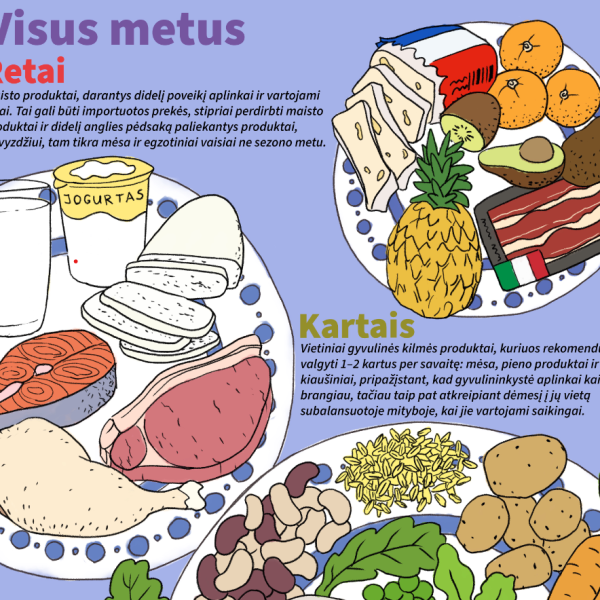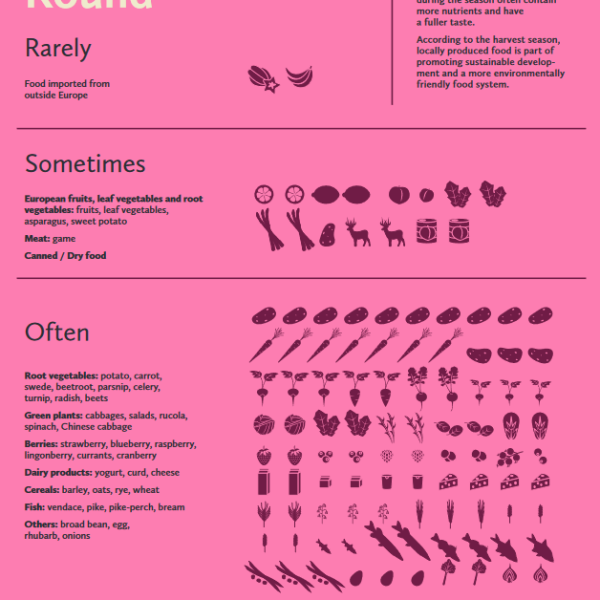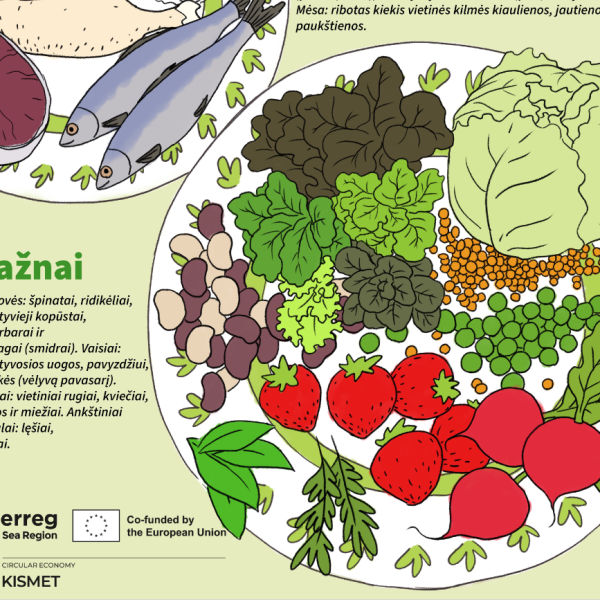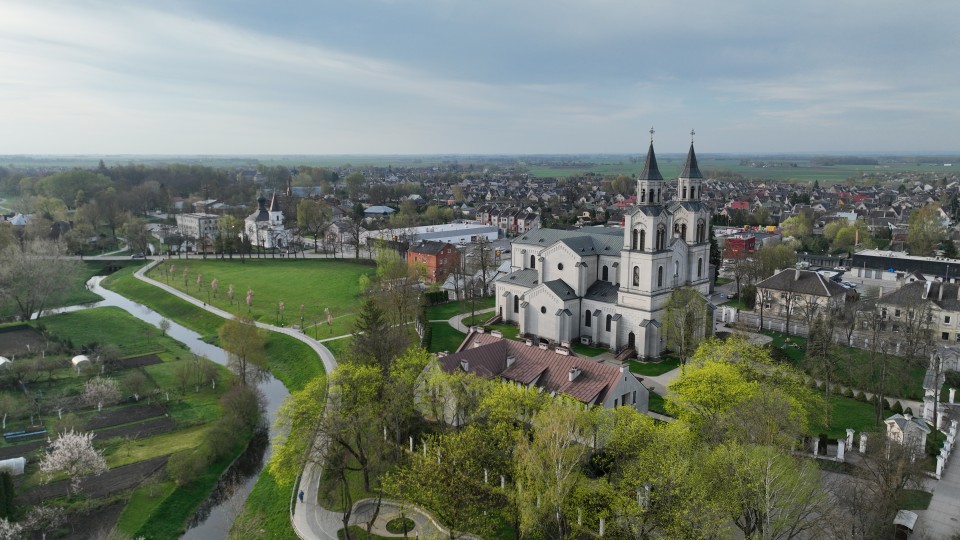The food pyramid is built on seasonal and local products according to environmental & health impacts. The pyramid is divided into three horizontal layers:
At the top are products that should be used rarely since they have a high environmental impact or are less healthy. These pro-ducts are, for example, imported products (rice, sugar, fruits) outside of Europe.
In the middle are products that can be used 2-3 times/week and are important to our diet but there is no need to eat them dai-ly, they are also usually sourced more locally/regionally, such as animal products.
At the base are foods that belong to the everyday diet, to a large degree regional/local foods, such as legumes, root vegeta-bles, and cereals.
How to do it
Suggested actions
- Evaluate the current situation with public meals using local food.
- Identify suitable units from public and private food services to test the concept.
- Establish connections with local producers, understand their sales channels, and raise awareness about the ben-efits of seasonal food.
- Benchmark the seasonal pyramid from Södertälje and adapt it to the local context.
- Develop a farming and food knowledge system to support direct purchasing from local suppliers and improve the local food chain.
- Organise a local workshop to facilitate dialogue and collaboration among stakeholders.
- Arrange meetings with experts to gather insights and introduce the tool to the target group. Seek expert advice and recommendations to enhance the implementation plan.
- Present the local version of the pyramid to the testing unit for evaluation and feedback.
- Test the pyramid in collaboration with the chosen unit, collect feedback, and make adjustments.
- Create a comprehensive implementation plan, including a digital format for easy access and user-friendliness.
Local adaptations
South Savo, Finland
South-Eastern Finland University of Applied Sciences, XAMK, piloted a local version of the seasonal food pyramid in the Savonlinna area. In cooperation with the Public Food Services of Savonlinna, this initiative aims to promote sea-sonal and local food consumption. The project involves 25 units, targeting different age groups, with activities such as a memory game (card game) about seasonal local food for kindergartners, a nature adventure game about local food for elementary students, and a gamified escape room-style implementation about local food for secondary students. In addition, XAMK will produce seasonal images of local food materials, such as root vegetables and fish from local lakes, for elderly residents. These images are intended to help elderly people with memory problems remember the local food available in their area. To support the seasonality thinking approach, XAMK is preparing marketing material to inform different customer groups about this approach. Seasonal posters and participatory events will help encour-age seasonal thinking and sustainable food habits in the community.
Vilkaviškis, Lithuania
The Lithuanian Innovation Centre (LIC) aims to promote the consumption of seasonal food in local canteens through various initiatives. These include raising awareness among canteen operators, consumers, producers, and municipal officers via workshops and local communications. LIC also plans to collaborate with nearby farmers, cooperatives, and suppliers to develop a knowledge-sharing system, encouraging direct sourcing and educating stakeholders on season-al food. By engaging local governments and organizations, LIC seeks to foster a collaborative ecosystem that supports seasonal food integration into canteen menus.
KISMET Actions & Tools
Marketing tool for the seasonal thinking pyramids (South Savo)
The food pyramids are built on seasonal and local products according to environmental & health impacts. Each pyramid is divided into three horizontal layers: At the top are products that should be used rarely since they have a high environmental impact or are less healthy. In the middle are products that can be used 2-3 times/week and are essential to our diet, but there is no need to eat them daily; they are also usually sourced more locally/region-ally. At the base are foods that belong to the everyday diet, such as regional/local foods, such as legumes, root vegetables, and cereals, to a large degree. The Seasonal Pyramids promote the use of local foods in the South Sa-vo region according to the harvest season and raise awareness of local foods to consumers. The posters are produced by XAMK, Finland and can be each downloaded below.
Seasonal Board Games (South Savo)
South Savo produced a seasonal game for elementary schools and an escape game for secondary schools with the objective of promoting seasonal thinking. Further information can be found on their website, and the games can be downloaded below.
The „Harvest Season Heroes“ board game
The Harvest Season Heroes board game is designed for schools in the Savonlinna region. The goal is to inspire stu-dents to learn about sustainable food systems through gameplay. The game introduces players to both domestic and imported ingredients, as well as the producer of school meals, Savonlinna Food Services. Points are awarded based on how close the ingredient on the picture card is produced. Special points (4 points, star) are given for ingre-dients from the Savonlinna local area.
„Who Turned the Cabbage Heads??“ – Escape Game
The game Who Turned the Cabbage Heads?? is designed to support students’ learning about sustainable food systems. In this escape game, players work together to solve various puzzles. Progress in the game is only made once a puzzle is successfully solved. The goal is to complete all tasks before time runs out. The game introduces topics such as local products, imported ingredients, and food packaging labels, allowing for further discussion after the game. It is specifically designed for schools in the Savonlinna region.
Visualisation of food pyramids for Lithuania (LIC, Vilkaviškis )
The visual model of the food pyramids for Lithuania effectively illustrates the availability and benefits of locally sourced, seasonal foods throughout the year. The visual not only highlights the variety of food options that are in season but also promotes sustainable eating habits by encouraging the consumption of foods that are environ-mentally friendly and support local agriculture. It serves as a valuable resource for raising awareness and guiding both consumers and decision-makers toward making healthier, more sustainable food choices.
Related knowledge
Seasonal Pyramids – Diet for a Green Planet
The seasonal food pyramid promotes a balanced and sustainable diet. It suggests consuming high-impact products sparingly, including local animal products 1-2 times per week, and focusing on everyday foods like local legumes, root vegetables, and cereals. By following these pyramids, it is possible to make conscious choices that support health and the environment, considering seasonal variations and local circumstances.
The Seasonal Food Guide
The Seasonal Food Guide is a national database of seasonal food available in the US. It shows when and where locally grown produce is in peak season and has maximum flavor by selecting a state and the time of the user’s interests. The Seasonal Food Guide includes links to recipesand in-depth information on local, seasonal fruits, vegetables, herbs, le-gumes, and nuts from Real Food Encyclopedia.
Finland eats from Satakunta – „Sikses Parasta“ local food
„Sikses Parasta“, a dialect term in Satakunta, is also a project name in Satakunta that promotes locally grown, pro-duced, and processed products. The website introduces visitors to, among other things, a series of 16 videos that raise awareness about local food, as well as an innovative food game. Partners of the Sikses parasta project include Pro-agria Länsi-Suomi, Pyhäjärvi-instituutti and Satafood. The project is funded by European Agricultural Fund for Rural development: Europe invests in rural areas.







